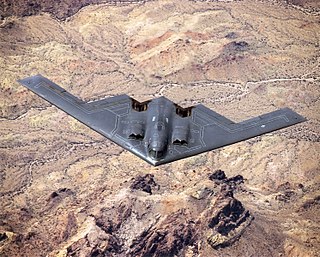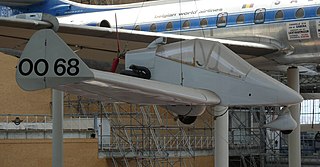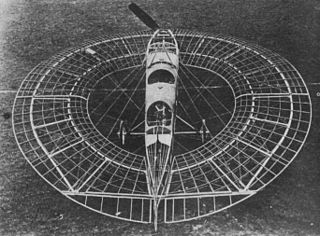
A flying wing is a tailless fixed-wing aircraft that has no definite fuselage, with its crew, payload, fuel, and equipment housed inside the main wing structure. A flying wing may have various small protuberances such as pods, nacelles, blisters, booms, or vertical stabilizers.

John William Dunne was a British soldier, aeronautical engineer and philosopher. As a young man he fought in the Second Boer War, before becoming a pioneering aeroplane designer in the early years of the 20th century. Dunne worked on automatically stable aircraft, many of which were of tailless swept wing design, to achieve the first certified stable aircraft. He later developed a new approach to dry fly fishing before turning to philosophy, where he achieved some pre-eminence and literary influence through his theory on the nature of time and consciousness, called "serialism".

Pterodactyl was the name given to a series of experimental tailless aircraft designs developed by G. T. R. Hill in the 1920s and early 1930s. Named after the genus Pterodactylus, a well-known type of Pterosaur commonly known as the pterodactyl, all but the first were produced by Westland Aircraft Ltd after Hill joined them.

A tailless aircraft has no tail assembly and no other horizontal surface besides its main wing. The aerodynamic control and stabilisation functions in both pitch and roll are incorporated into the main wing. A tailless type may still have a conventional vertical fin and rudder.
The Dunne D.1, was an experimental tailless aircraft built in the United Kingdom in 1907. It comprised a main unit which could be flown as a glider, to which a chassis unit with power train could be added. The glider achieved a short flight in 1907. The D.1 was later rebuilt as the powered D.4, which achieved short hops in 1908.

The Dunne D.5 was an experimental aircraft built in the United Kingdom in 1910. Designed by J. W. Dunne and built by Short Brothers at Leysdown, A tailless swept-wing biplane, the D.5 was the first aircraft built by his company, the Blair Atholl Aeroplane Syndicate Ltd. Like its military predecessors it was driven by twin pusher propellers, but it had a considerably more powerful engine.

The Granger Archaeopteryx is a British single-engined, tailless parasol monoplane designed and built in the late 1920s by two brothers, R.F.T. and R.J.T. Granger. The sole example built is currently under restoration for flight.

The Dunne D.8 of 1912 was a tailless swept wing biplane, designed by J. W. Dunne to have inherent stability. One example was supplied to RAE Farnborough. License-built Burgess-Dunne models were used by the US Signal Corps and United States Navy and the short-lived Canadian Aviation Corps. It was the latter's first and only warplane.

The Short S.27 and its derivative, the Short Improved S.27, were a series of early British aircraft built by Short Brothers. They were used by the Admiralty and Naval Wing of the Royal Flying Corps for training the Royal Navy's first pilots as well as for early naval aviation experiments. An Improved S.27 was used by C.R. Samson to make the first successful take-off from a moving ship on 9 May 1912.

The ASL Valkyrie was a canard pusher configuration aircraft designed by the Aeronautical Syndicate Ltd in 1910. Examples were widely flown during 1911 and were used for instructional purposes at the ASL flying school, which was the first occupant of Hendon Aerodrome in London.
The Mersey Monoplane was a prototype two-seat British pusher configuration monoplane of the early 1910s. A single example was built and entered into the 1912 British Military Aeroplane Competition but crashed during the trials and was destroyed.

The Short S.36 was a British two-seat tractor biplane, built by Short Brothers for Francis McClean in 1911. It was later developed into the Short S.41 and Short S.45, which were the first of a long series of similar aircraft built for the RNAS and RFC.

The Waterman Arrowbile was a tailless, two-seat, single-engine, pusher configuration roadable aircraft built in the US in the late 1930s. One of the first of its kind, it flew safely but generated little customer interest, and only five were produced.

The Sud-Est or SNCASE SE-2100, sometimes known as the Satre SE-2100 after its designer, was a tailless, pusher configuration touring monoplane with a single engine and cabin for two. Only one was built.

The Hanriot H.110 was an unusual pusher configuration, twin boom, single seat fighter aircraft built in France in the early 1930s. It proved to be slower and less manoeuvrable than its contemporaries and failed to reach production, even as the Hanriot H.115 after receiving a more powerful engine and cannon armament.
The Teichfuss Cicogna was an Italian tailless single-seat motor glider designed by Luigi Teichfuss and flown in 1936.

The 1910 Deperdussin monoplane was the first aircraft to be built in significant quantities by Aéroplanes Deperdussin. The type was produced in a number of variants which were flown successfully in air races and gained several records during 1911, and was used by the Australian Central Flying School at Point Cook, Victoria. Several have survived, including an airworthy example in the Shuttleworth Collection in England.

The French tailless Pottier P.40 was the first aircraft designed by Jean Pottier. It flew in 1975.

During the pioneer years before the First World War, Cedric Lee and G. Tilghman Richards in the UK built and flew a series of aircraft having a novel flat ring-shaped or annular wing. They built both biplane and monoplane types, and in 1913 their first monoplane proved to be an early example of a statically stable aircraft.

The Nieuport-Delage NiD 940 was a French, tailless, pusher configuration touring aircraft first flown in 1934. It suffered from longitudinal instabilities and despite modifications and a more powerful engine, it did not receive its Certificate of Airworthiness.

















